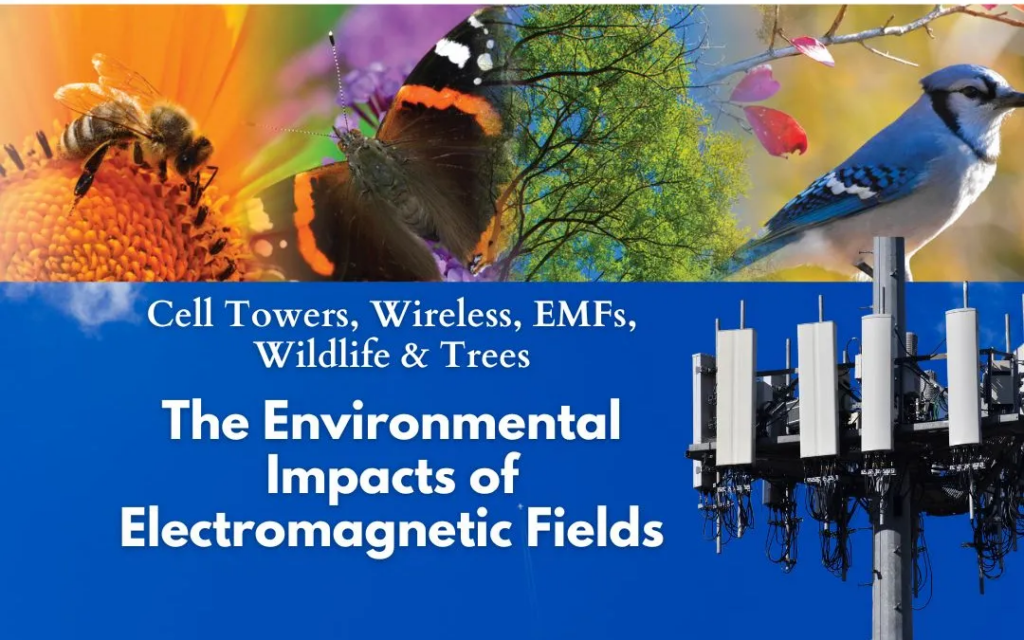In our increasingly connected world, the number of devices emitting electromagnetic fields (EMFs) has skyrocketed, from smartphones and Wi-Fi routers to smart home systems and electric vehicles. While these technologies undeniably bring convenience and efficiency to our lives, they also raise new concerns about their impact on our health and the environment around us. As we strive towards more sustainable living, we must consider these emerging EMF issues and how they fit into our broader goals of health, well-being, and ecological balance.
Sustainable living isn’t just about recycling or using less water; it encompasses a holistic approach to reducing our environmental footprint while enhancing our quality of life. Addressing EMF exposure is an often overlooked but vital component of this approach. By understanding and striving to mitigate the effects of EMFs, we can take meaningful steps towards a healthier and more sustainable future.
This post will look into what EMFs are, their potential health and environmental impacts, and practical ways to reduce exposure in our daily lives. We’ll also explore how integrating EMF awareness into our sustainability practices can lead to a more comprehensive and effective approach to living sustainably.
So come along with us as we seek to integrate with this modern intersection of technology, health, and sustainability.
Understanding EMFs in the Context of Modern Life
Electromagnetic fields (EMFs) are invisible areas of energy, often referred to as radiation, that are associated with the use of electrical power and various forms of natural and man-made lighting. These fields can be broadly categorized into two types: ionizing radiation, which includes X-rays and gamma rays, and non-ionizing radiation, which includes radio waves, microwaves, and visible light.
In our daily lives, we are constantly surrounded by sources of non-ionizing EMFs. Common household devices such as smartphones, Wi-Fi routers, laptops, and microwave ovens are significant emitters of this type of radiation. Additionally, the proliferation of smart home technology and wireless networks has increased our exposure to EMFs more than ever before.
Understanding the growing sources and different types of EMFs is the first step in addressing their impact. While natural EMFs from the Earth and the Sun have always been part of our environment, man-made EMFs are new variables in our lives that have only recently come about with the advent of modern technology. This surge in EMF exposure has led to growing concerns about potential health risks and environmental impacts.
When it comes to sustainable living, it’s essential to recognize the role of EMFs and take steps to manage exposure. By doing so, we can better align our technological advancements with the principles of sustainability, ensuring that our pursuit of convenience and efficiency does not come at the cost of our health and well-being, nor that of the environment around us.

The Intersection of EMFs and Sustainable Living
Sustainable living is about making choices that reduce our environmental impact and promote a healthier, more balanced lifestyle. It’s a matter of addressing everything from waste reduction and conservation of resources to cultivating a cleaner and safer environment. An often overlooked aspect of sustainable living is the management of EMF exposure, which can significantly contribute to overall well-being.
Sustainable Living Principles
At its core, sustainable living aims to meet the needs of the present without compromising the ability of future generations to meet their own needs. This includes:

- Resource Conservation: Using resources more efficiently and minimizing waste.
- Health and Well-being: Promoting practices that support physical and mental health.
- Environmental Protection: Reducing pollution and protecting ecosystems.
Incorporating EMF Awareness
Addressing EMF concerns is integral to these principles. While technology enhances our lives in many ways, the unchecked proliferation of EMF-emitting devices can have unintended consequences. By incorporating EMF awareness into sustainable living practices, we ensure that our technological advancements do not undermine our health or the environment.
Holistic Health Approach
Truly sustainable living inherently promotes a holistic approach to health, considering not just diet, exercise, and other conventional modalities of health but also environmental factors. EMF exposure is a growing area of concern within this holistic framework. Research suggests that prolonged exposure to high EMF levels can affect sleep patterns, stress levels, and overall health, especially in those highly sensitive to these frequencies. Therefore, managing EMF exposure is a key piece in maintaining a balanced and healthy lifestyle.

Incorporating EMF awareness into sustainable living means taking proactive steps to reduce exposure, such as using EMF-shielding products, opting for wired connections instead of wireless, and designing living spaces that minimize EMF hotspots. By doing so, we can create environments that support both technological convenience and sustainable health practices.
Health and Environmental Impacts of EMFs
In today’s increasingly technological world, understanding the potential impacts of EMF exposure is essential to integrate EMF management into our sustainable living practices. While the scientific community continues to study and debate these effects, a growing body of research suggests that EMFs can have significant health and environmental implications.
Potential Health Risks
Several studies have explored the potential health risks associated with prolonged exposure to EMFs, particularly from high-frequency sources like cell phones and Wi-Fi routers. Some of the potential health concerns include:

- Sleep Disorders: EMF exposure, especially from devices kept near the bed, can disrupt sleep patterns, leading to insomnia and poor sleep quality.
- Headaches and Fatigue: Some individuals report experiencing headaches, fatigue, and cognitive disturbances after prolonged exposure to EMFs.
- Neurological Effects: There is ongoing research into the possible link between EMF exposure and neurological conditions such as anxiety, depression, and neurodegenerative diseases.
- Cancer Risk: Although the evidence is not conclusive, some studies have suggested a potential link between long-term EMF exposure and an increased risk of certain types of cancer, particularly brain tumors.
Environmental Effects
EMFs do not only affect human health; they can also have detrimental effects on the environment and wildlife. Some documented impacts include:
- Wildlife Disruption: EMFs can interfere with the navigation and migration patterns of birds and other animals. For instance, certain frequencies can disrupt the magnetoreception abilities of birds, causing disorientation.
- Impact on Pollinators: Bees and other pollinators are sensitive to EMFs, which can affect their behavior, foraging patterns, and ultimately their survival. This has broader implications for biodiversity and agriculture.
- Ecosystem Imbalance: Prolonged exposure to EMFs can lead to changes in the behavior and physiology of various species, potentially disrupting entire ecosystems.

Current Research and Debates
While there is substantial evidence pointing to the potential risks of EMF exposure, the scientific community continues to investigate and debate these effects. Some studies show significant health impacts, while others find minimal or no effects. This ongoing debate underscores the need for further research to reach a more definitive understanding.
As we consider the integration of EMF awareness into sustainable living, it’s important to stay informed about the latest research and to adopt precautionary measures to mitigate any potential risks in this relatively new field of concern.
Tips for Reducing EMF Exposure in a Sustainable Home
Integrating EMF awareness into sustainable living involves taking practical steps to minimize exposure while maintaining the convenience and efficiency that modern technology offers. Here are some effective strategies to reduce EMF exposure in your home:

Use Wired Connections
- Ethernet Cables: Instead of relying on Wi-Fi, use Ethernet cables for internet connections. This significantly reduces EMF exposure from wireless signals.
- Wired Peripherals: Opt for wired versions of common peripherals like keyboards, mice, and headphones
Router Placement
- Distance: Place Wi-Fi routers as far away from living and sleeping areas as possible. Avoid placing them in bedrooms or close to frequently used sitting areas.
- Timing: Turn off Wi-Fi routers at night or when not in use to reduce exposure during sleep. Using an outlet timer is a great solution for this.
Device Usage
- Airplane Mode: Use airplane mode on smartphones and tablets when they are not in use or when sleeping.
- Speakerphone and Headsets: Use speakerphone or wired headsets to reduce direct exposure from mobile phones.
Buying Smart Solutions
Appliances and Electronics
- Low-EMF Options: Choose appliances and electronics specifically designed to emit lower levels of EMFs. Look for products that have been tested and certified for low EMF emissions.
- Energy Efficiency: Energy-efficient appliances often emit lower levels of EMFs and also align you with more sustainable living practices.

EMF Shielding
- Shielding Materials: Use EMF shielding paints, fabrics, and window films to create barriers against EMF radiation. These products can be particularly useful in bedrooms and other high-use areas.
- Phone Cases: Consider using EMF-blocking phone cases and pouches to reduce exposure from mobile devices.
- Shielded Cables: Use shielded electrical cables to minimize EMF emissions from the electrical wiring in your home
Aires Tech Devices:

- Lifetune Products: Aires Tech offers a range of devices designed to reduce EMF exposure by neutralizing harmful EMF radiation. Their products include personal protection devices, home protection systems, and portable solutions.
- How They Work: Aires Tech devices use patented technology to restructure EMF radiation into a more biologically compatible form. This helps to mitigate potential health risks associated with EMF exposure.
- Benefits: These devices are easy to use and can be integrated seamlessly into your daily life, providing protection whether you’re at home, at work, or on the go. Products like the Lifetune One can be attached to personal electronic devices, while the Lifetune Zone Max can protect entire living spaces.
Closing Thoughts
Addressing EMF concerns is an essential component of sustainable living that often goes overlooked. As we have seen, understanding EMFs, their sources, and their potential impacts on health and the environment is crucial for creating a healthier living environment. By incorporating EMF awareness into our sustainable living practices, we not only protect our well-being but also contribute to the overall goal of reducing our environmental footprint.
Reducing EMF exposure can be achieved through practical steps such as using wired connections, strategically placing routers, and choosing low-EMF products. Additionally, employing EMF shielding solutions, including innovative products from Aires Tech, can further protect ourselves and our homes from harmful radiation.
By making these adjustments and being mindful of our EMF exposure, we can ensure that our pursuit of technological convenience does not compromise our health or the environment. Integrating these practices into our daily routines helps us align with the principles of sustainable living, promoting a balanced and healthier lifestyle.
As we continue to explore and implement sustainable practices, let’s remember to include EMF awareness as a key aspect of our journey towards a more sustainable and harmonious way of life.








